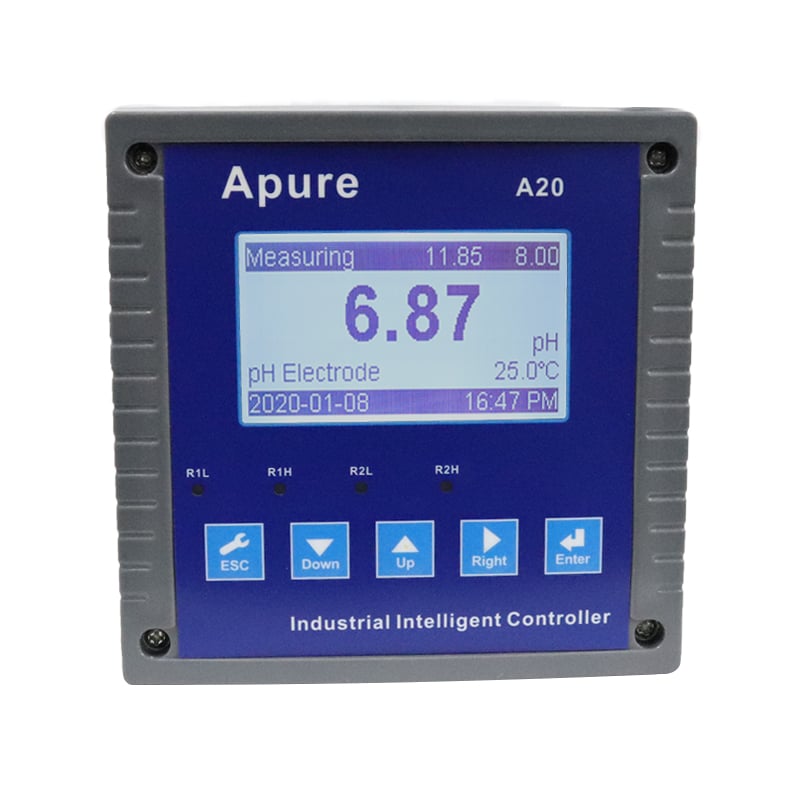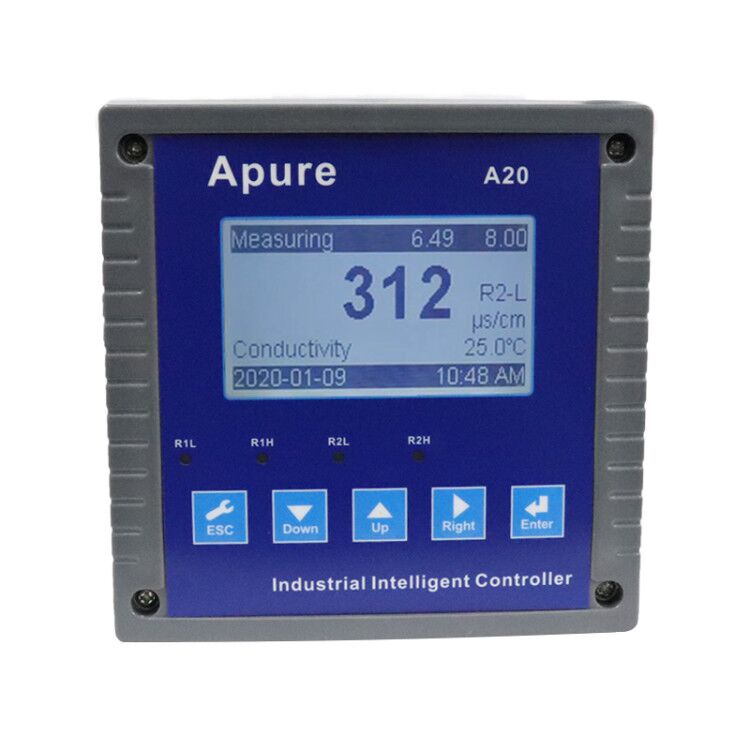
pH and conductivity are key parameters for measuring the pH of a substance while monitoring the level of nutrients, salts or impurities present. pH and conductivity measurements are used in a variety of applications, including industrial water and wastewater treatment, boiler maintenance and agriculture, as well as aquariums and aquaculture.
pH and conductivity meters are a fast, reliable and inexpensive way to measure the pH and ionic content of liquids. So, how do these meters work?
What is pH and conductivity?
Hydrogen potential or “pH” is a measure of the concentration of hydrogen ions in a sample and is used to determine the acidity or alkalinity of a product. pH values range from 0-14, with 0 being acidic, 7 being neutral and 14 being basic.
Conductivity is a measure of the concentration of ions present in a sample. It is calculated by the ability of a substance to transmit an electric current in a defined area. Conductivity is measured in units called Siemens (S) (e.g. milliSiemens per centimeter mS/cm or microSiemens per centimeter μS/cm).
Is there a relationship between pH and conductivity?
pH is a measurement of a specific ion (i.e. hydrogen). In contrast, conductivity is a non-specific measurement of the concentration of positively and negatively charged ions in a sample.
In summary, the relationship between pH and conductivity is that the presence of hydrogen ions affects the pH of a substance, and the presence of these ions may affect conductivity. However, hydrogen ions represent only a small fraction of the ion concentrations measured by conductivity meters. Therefore, given this, the relevance of the relationship will depend on the presence of hydrogen compared to other concentrations of non-pH determining ions.
How pH and conductivity meters work?
A variety of electrodes and meters are available for specific applications. On the Apure website, you can find pH and conductivity meters built into one electrode or as separate electrodes. For more information on specific electrodes, please contact our technical team. Here, we will describe the general working principle of pH and conductivity meters. So, how do these instruments work?
Conductivity meter
Conductivity is measured by conductance between two or four electrodes using the current method or potentiometric method. When the electrodes are immersed in the sample, the electrodes cause a current to pass through the sample solution. The relative concentration of ions in the solution will determine the conductivity or resistivity of the sample. The conductivity is expressed in Siemens units.
- 2 electrode probes (amperometers) – they work through two electrodes that are isolated from each other. Made of non-reactive materials and constructed so that both will be in contact with the sample at the same time. These two electrodes pass current through the sample at a specific frequency, the more ions present, the higher the EC reading.
- 4 Electrode Probe (Potentiometer) – The electrode body has four platinum rings. The top and bottom rings (on the outside) apply AC voltage to the sample and sense current. The center ring (placed on the inside of the top and bottom rings) measures the potential drop in the current generated by the external electrode to give a conductivity reading.
pH Meter
The pH electrode consists of a reference electrode, a reference solution, a reference fluid connection and a glass bulb with a hydrated gel layer. Once the electrode is immersed in the sample, a current is generated and the charge of the reference solution inside the bulb is measured compared to the solution on the outside of the gel layer. The result is a pH measurement.
What are the uses of pH and conductivity meters?
Electrical pH and conductivity are important in a number of applications and industries. Below are just a few examples of the many applications.
Industrial Water Treatment
Desalting is affected by water quality parameters including temperature and pH. As the temperature increases, the diffusivity of the membrane increases and both water and salt pass through more easily. Fortunately, the increase in water passage is greater than the decrease in desalting rate. Membrane performance is less sensitive to pH changes except in the vicinity of the operating range. However, pH value will affect the scaling index of raw water, which will lead to hydraulic irreversible film scaling and membrane water flux loss. Strict pH control can help prevent film scaling, which might otherwise result in expensive RO film replacement.
Membranes are a small barrier between raw water contaminants and clean water. Real-time monitoring is essential to know the integrity of the membrane and the entire process at all times. Salt can be measured as a total dissolved solid (TDS), but the process involves evaporation of the sample and is time consuming. Instead, conductivity can be used as a cheap and effective measure to estimate salt content.
Aquariums and Aquaculture
An easy way to check the salinity of any water is to use a pH and conductivity meter. Alternatively, you can manually convert to total dissolved solids (TDS) or salinity, or you can simply use a pH and conductivity meter with this conversion feature built in. An example of a pH and conductivity meter with this feature can be viewed here.
Measuring salinity by conductivity is important for measurements because it affects the regulation of osmotic pressure in both brackish and freshwater fish. Fish species have different optimal pH levels, with the ideal range generally being between 6.5 and 9 pH. Outside of this range you will see slow or sub-optimal growth, no reproduction and extreme cases (pH 4 and below, pH 11 and above) of mortality.
Boiler Maintenance
There is a large amount of feed water in the boiler system. This water contains impurities that can cause problems over time. This occurs during typical boiler use as the water is heated and turned into steam and impurities are left behind. Over time, these will accumulate and affect the efficiency of the boiler system. Having a pH and conductivity meter makes it easy to monitor the water for impurities to indicate when boiler drainage should occur. Monitoring pH is also important because acidic water is very corrosive and alkaline water can lead to system scaling.
Agriculture
Conductivity can be used to infer the amount of salinity, dissolved nutrients and dissolved solids in the soil. This is a good way to determine if more water or fertilizer is needed. Soil pH affects the uptake of key nutrients, so when the pH is outside the ideal range, your plants and crops may not be getting optimal nutrient uptake and therefore not growing to their full potential.
Get accurate measurements on your pH conductivity meter
Tip: For accurate results – look for pH and conductivity meters with automatic temperature compensation.
One parameter that can affect your pH and conductivity meter results is temperature. If the solution is at a higher temperature, the resistance may drop and therefore increase the conductance. Conversely, if the solution cools, conductance will decrease and increase resistivity.
To ensure accuracy, pH and conductivity meters need to be properly calibrated before each use. In general, for pH values, you should use a pH buffer solution on either side of the expected result. For example, if you expect a result of 5.3 – you can use buffer solutions 4.01 and 7.00. The more calibration points you have on the linear pH scale, the more accurate you expect the result to be.
pH and conductivity meters are important tools for a range of applications and industries. While the inner workings are complex, they are designed to be robust and easy to use. Have questions about pH and conductivity? Need more help choosing the best pH and conductivity for your application please contact us
More articles on pH and EC:
How to maintain ph level for hydroponics
What is EC?
What is ec meter?
What is ORP?


